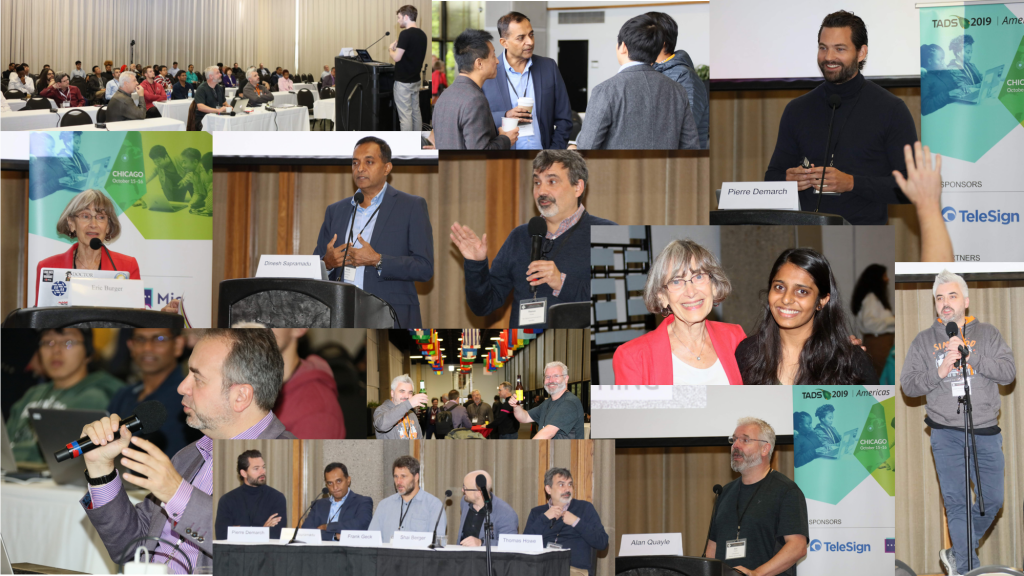TADSummit Americas 2019 ran on the 15-16 Oct, in parallel with the IIT RTC Conference. This weblog provides a summary of the presentations and discussions from TADSummit Americas Day 1 morning.
Thank you to TeleSign and Mio for sponsoring TADSummit Americas, all our partners (VoIP Innovations, Apidaze, IIT RTC Conf, IIT RTC Labs, Mind Commerce, Aplisay, The Fast Mode, Disruptive Analysis), all the world-class presenters, and both the in-person and remote attendees.
The combined conference kicked-off with a welcome from Professor Carol Davids, Chairman of Real-Time Communications Conference and Expo and Director of the Real-Time Communications Lab at the Illinois Institute of Technology. Carol and her team, including Warren Bent and Tom Costello, are responsible for running TADHack Chicago since 2014, and providing a home for TADSummit Americas in 2019.
I kicked off TADSummit Americas with an welcome:
- Thanking TeleSign, Mio, and all our partners for making TADSummit Americas possible;
- Defining TADSummit with a halloween themed word cloud, and focusing on Programmable Telecoms / Communications aka CXTech. The C stands for Connectivity, Communications, Collaboration, Conversation, Customer; X for Experience because that’s what matters; and Tech because the focus is enablers.
- Focusing in on why our No BS policy is important. Showing the many false narratives at play in the industry, and why TADSummit cuts through the BS to help everyone involved focus on building profitable businesses not fashionable marketing collateral.
Our first keynote came from Pierre Demarche, VP Product and Marketing, TeleSign on Identity, Authentication, and Programmable Telecoms. TeleSign were also a sponsor of TADHack Global, you’ll be hearing more about that in the afternoon of Day 1.
TeleSign is a leader in identity and verification solutions, in addition to being a leading global CPaaS provider. TeleSign was acquired by BICS in 2017, BICS is the world’s largest global inter-carrier operator. Together they are revolutionizing programmable communications. Not only through the wholesale price points and vast knowledge base about phone numbers. Also mashing up communication services with insights and ratings, transforming how businesses communicate with their customers.
Our second keynote came from Dinesh Saparamadu, CEO hSenid Mobile on eCPaaS (enterprise CPaaS) – we heard that acronym first at TADSummit Asia in May. hSenid Mobile were also a location sponsor of TADHack Chicago.
Enterprise CPaaS (eCPaaS) is an important development in CPaaS.
CPaaS platforms are maturing, the use of templates/wizards under a self-service model with IT governance brings a highly successful CPaaS operational model directly into the enterprise.
Review the hSenid Mobile story to explain how we’ve come to offer eCPaaS, and describe the core eCPaaS engine and value proposition.
Explain our eCPaaS go to market focus on the Banking industry, then expanding into Insurance, and beyond.
Thought-Leadership Panel Discussion: The Status and Future of Programmable Telecoms. With panelists:
- Pierre Demarche, VP Product and Marketing, TeleSign
- Frank Geck, Director of Customer Success, Mio
- Shai Berger, Founder and CEO Fonolo
- Dinesh Saparamadu, CEO hSenid Mobile
- Thomas Howe, CTO Ten Digit Communications
Questions:
- Has the industry lost its way? Given the jabber on APIs, AI, digital, transformation, video in the new voice, AR/VR, false messaging battles, blockchain, contextual comms, cloud comms, XaaS, etc.
- What are the greatest challenges facing programmable telecoms wrt enterprise adoption?
- What’s your prognosis for the spate of CPaaS acquisitions over the past few years?
- Will UCaaS ever achieve its dream of becoming THE enterprise communications platform?
- How will customer communications evolve? Currently it looks like lots of neat ideas, and a big integration headache.
- Omnichannel is dead! The goal is not to be everywhere, nor is it to be seamless or unified. Those are necessary, but they are not sufficient. How can the programmable telecoms deliver harmonized customer experiences. For example, a flight delay notification results in a push message so my airline’s app can fire up with other flight options, while an on-time notification is sent by SMS, and all the bloody email notifications stop!
I loved the discussion in this panel, we covered many points. In particular Thomas and Dinesh are at the sharp end of the business, and highlight the focused guerila sales approach necessary to build their enterprise focused CPaaS business. Finding a champion in solving a specific business problem and building out from there. While as you scale and have to use solution providers / integrators, it’s critical to build defensible value to no be ‘integrated’ out of the solution.
The morning session finished with the conference Keynote from Eric Burger, CTO FCC on “How to Make a Difference: Communication Protocols and Regulatory Protocols.”
Eric has had the privilege to have a classic R&D career that has included key positions with technology leaders, including MCI, BEA Systems, Neustar, Brooktrout, Centigram, and Cable & Wireless. His career track has gone from being a Research Engineer and Member of the Technical Staff, Program Manager, Engineering Director, VP Engineering, SVP and Chief Technology Officer, as well as General Manager and Center Director. He is currently on loan from Georgetown University to the Federal government as the Chief Technology Officer of the FCC.
Engineers spend a lot of thought coming up with neat and cool protocols to do interesting stuff. Lawyers spend a lot of thought about constructing rules to ensure markets do the right thing. Both communities (usually) have their hearts in the right places. However, misunderstandings abound. This talk will give insights into the priorities and realities of the regulators, and how engineers, and by this I mean YOU, can constructively contribute to making the world a better place. There will be some specific case studies, such as how regulations can address issues such as illegal robocalling (from annoyance to destroying people’s financial lives) and public safety (from improving outcomes to literally saving lives).
I wrote about the industry’s need to comment on FCC-18-132, it was great Eric could share the his results of that industry’s comment and its impact on the ruling.

